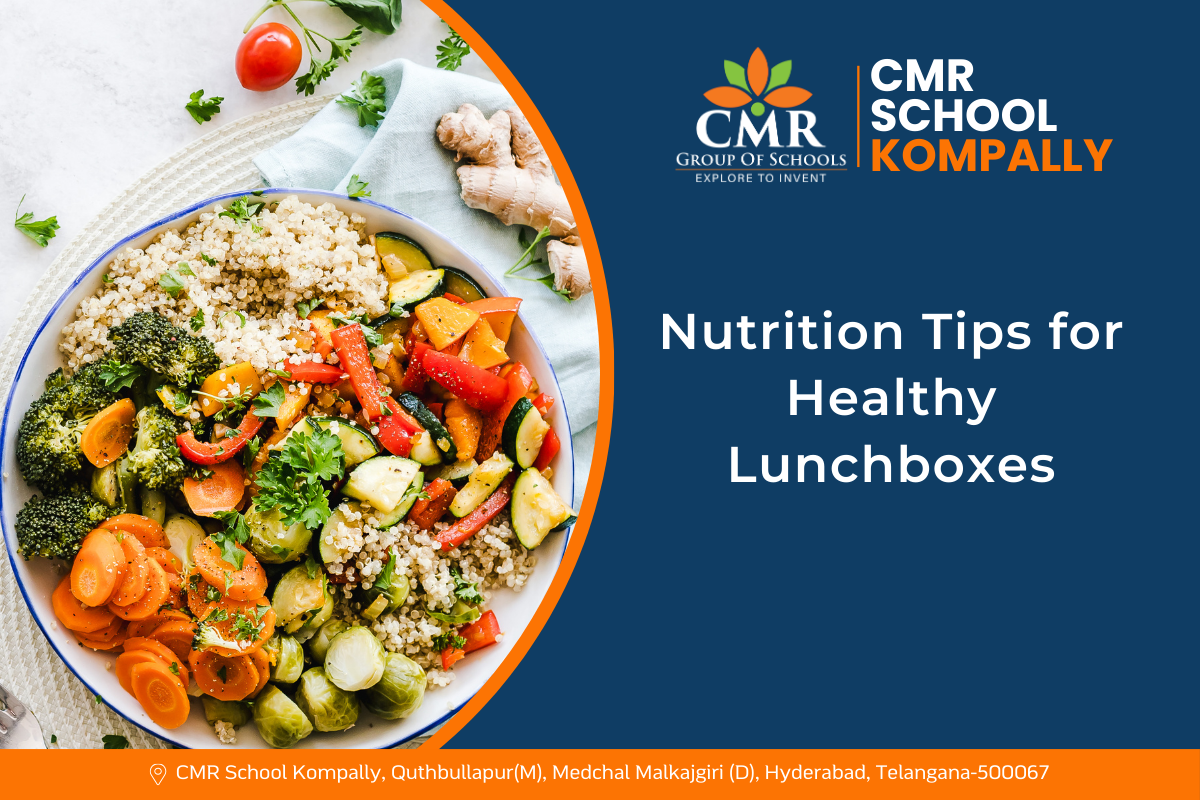Let’s be honest — packing a healthy lunchbox every day can feel like a chore, especially on busy mornings. But here’s the good news: healthy doesn’t have to be hard.
At CMR School, Kompally, we believe nutrition is the fuel that powers learning, play, and growth. A well-balanced lunchbox helps students stay focused, energized, and happy throughout the day. In this guide, we’ll walk you through practical, parent-friendly tips to pack meals that are both nutritious and delicious.
Let’s unpack the lunchbox together, shall we?
1. Introduction
Every parent wants their child to eat well. But between picky appetites and rushed mornings, packing the “perfect lunchbox” can feel overwhelming. That’s why we’re here to help. At CMR School, Kompally, we encourage families to embrace simple, realistic nutrition. This isn’t about fancy ingredients or Pinterest-worthy meals — it’s about balance, variety, and love.
2. Why Nutrition Matters for School Kids
Think of food as your child’s daily fuel. A healthy lunchbox supports:
- Better concentration in class
- Stable energy levels
- Stronger immunity
- Healthy growth and development
Kids who eat right, think right. It’s as simple as that.
3. The Balanced Lunchbox Formula
Want an easy formula to follow? Try this:
Carb + Protein + Fruit/Vegetable + Hydration = Balanced Lunchbox
Let’s break that down:
- Carb: Chapati, rice, bread, idli, pasta
- Protein: Eggs, dal, paneer, chicken, tofu
- Fruit/Vegetable: Seasonal and colorful
- Hydration: Water or homemade juice
Stick to this mix, and you’re already winning.
4. Include All 5 Food Groups
Aim for variety across the five main food groups:
- Grains – Whole wheat roti, brown rice, oats
- Protein – Boiled eggs, sprouts, beans
- Dairy – Cheese cubes, yogurt, buttermilk
- Fruits – Apple slices, banana, grapes
- Vegetables – Cucumber sticks, peas, cooked sabzi
More colors = more nutrients. 🌈
5. Fun with Fruits and Vegetables
We get it — kids can be veggie-averse. Here’s how to make them exciting:
- Cut fruits into fun shapes using cookie cutters.
- Roll veggies into parathas or wraps.
- Make fruit skewers or veggie pops.
- Add natural dips like hummus or curd for extra flavor.
You’re not hiding the veggies — you’re dressing them up!
6. Smart Swaps: Healthier Alternatives
You don’t have to ban favorite foods — just upgrade them:[
| Instead of… | Try This… |
|---|---|
| White bread | Whole wheat/multigrain bread |
| Chips | Roasted makhana or chana |
| Sugary drinks | Coconut water or lemon juice |
| Fried snacks | Baked samosas or dhokla |
| Chocolate bars | Dates, figs, or nut laddoos |
It’s all about keeping the flavor, not the junk.
7. Hydration is Just as Important
Dehydration = fatigue + headaches + poor focus.
Tips:
- Send a clean, refillable water bottle daily.
- Avoid aerated or sugary drinks.
- Include fluids like buttermilk, coconut water, or lemonade (no added sugar!).
Water is the unsung hero of every lunchbox.
8. Avoid These Common Lunchbox Mistakes
Even with good intentions, some common mistakes can sneak in:
- Overpacking food – leads to waste and pressure to finish.
- Repeating the same meals – kids need variety.
- Ignoring food safety – some items spoil quickly.
- Packing too many sweets or snacks.
Keep it simple. Keep it fresh. Keep it fun.
9. Tips for Fussy Eaters
Is your child a picky eater? You’re not alone!
Try these strategies:
- Involve them in menu planning.
- Introduce one new item per week — slowly.
- Use positive talk around food.
- Keep portions small and colorful.
- Praise trying — even if they don’t finish.
Remember: consistency beats force.
10. Easy Prep Ideas for Busy Mornings
No time? No problem.
Plan Ahead:
- Chop veggies and fruits the night before.
- Pre-boil eggs or soak sprouts weekly.
- Use compartment lunchboxes for quick assembly.
Quick combos:
- Veg wrap + fruit + nuts
- Idli + coconut chutney + banana
- Egg sandwich + cucumber sticks + curd
Think of it like a puzzle — everything has a spot.
11. Packing Tips to Keep Food Fresh
No one likes soggy chapatis or spoiled curd!
- Use insulated lunchboxes or thermos containers.
- Wrap rotis in foil to keep soft.
- Avoid foods that spoil fast in heat.
- Use ice packs for dairy if needed.
Fresh food = happy tummy = happy learning.
12. Allergies and Special Diets
If your child has allergies or dietary needs:
- Inform the school clearly.
- Use labels in the lunchbox if needed.
- Share alternative snack ideas with your child.
- Join parent groups to share allergy-safe recipes.
Safety first — always.
13. Getting Kids Involved
The more involved your child is, the more likely they are to eat their lunch!
- Let them pick fruits and snacks from the store.
- Ask them to pack their own lunch with guidance.
- Show them how to wash and cut fruits (age-appropriate).
It builds food responsibility and confidence.
14. CMR School’s Nutrition-Friendly Policy
At CMR School, Kompally, we:
- Encourage home-packed, balanced meals.
- Discourage junk food and sugary treats.
- Provide nutrition education in classrooms.
- Support parents with dietitian-led workshops.
We’re your partner in health — every step of the way.
15. Conclusion
Packing a healthy lunchbox doesn’t have to be a challenge. With the right mix of nutrition, color, and creativity, you can turn lunch into a meal your child looks forward to — not dreads.
At CMR School, Kompally, we believe food is not just fuel, it’s love in a lunchbox. Start small, stay consistent, and let every bite count.
16. Frequently Asked Questions (FAQs)
1. What are 3 must-have items in every lunchbox?
A source of energy (like rice or roti), a protein (like dal or paneer), and at least one fruit or vegetable.
2. How can I keep food warm until lunchtime?
Use insulated lunch containers and wrap items like chapati in foil to retain heat.
3. What are some healthy snacks I can add?
Nuts, roasted chana, fruit slices, boiled corn, or yogurt are great additions.
4. How do I handle food allergies at school?
Always inform the school in writing and label your child’s food clearly. Keep emergency meds in the school if needed.



